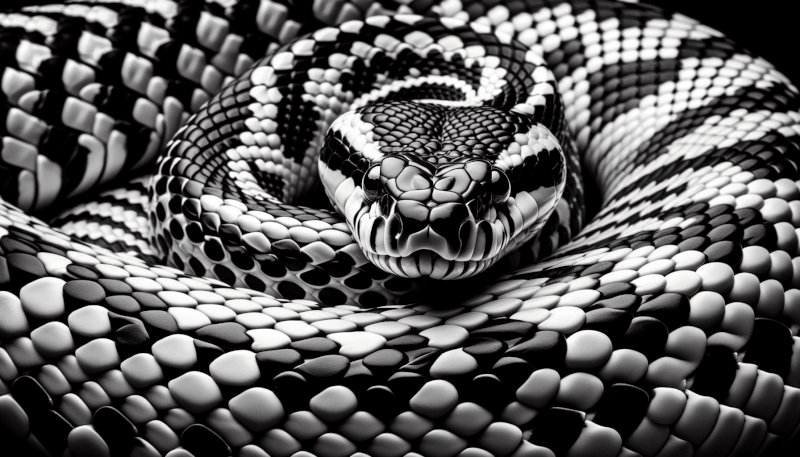Are you ready to uncover the mystique of the captivating “Black And White Snake Alabama”? Prepare to be mesmerized as we delve into the intriguing details of this enigmatic creature. With its striking black and white patterns, this snake has captured the curiosity of many in Alabama. Get ready to embark on an adventure that explores the unique characteristics and captivating presence of the Black And White Snake Alabama.
Physical Description
Coloration
The black and white snake found in Alabama is known for its striking coloration. Its body is predominantly black, with bold white stripes or bands running along its length. The contrasting colors create a visually appealing pattern that helps the snake blend into its environment. The glossy black scales lend the snake a sleek and elegant appearance, while the white stripes provide a distinct contrast.
Size and Length
In terms of size, the black and white snake in Alabama is considered to be of medium length. On average, it measures between 3 to 4 feet long, though some individuals may reach lengths of up to 5 feet. While not as large as some of its snake counterparts, the black and white snake is still an impressive sight to behold.
Venomous Features
While there are venomous snakes in Alabama, the black and white snake is not one of them. It is important to note that the coloration of a snake does not indicate its venomous nature. The black and white snake found in Alabama is harmless and poses no threat to humans. Its lack of venomous features is a relief to those who may encounter it in the wild.
Habitat and Range
Preferred Habitat
The black and white snake has a preference for wooded areas, where it can make use of the dense vegetation and ample cover provided by fallen logs and leaf litter. This snake feels most at home in forests, woodlands, and even near water sources such as creeks and rivers. It showcases a remarkable adaptability to different types of habitats, making it a versatile and successful species.
Distribution in Alabama
The black and white snake can be found throughout Alabama, as it inhabits a wide range of ecosystems within the state. From the northern mountains to the southern coastal regions, this snake has managed to establish its presence across various terrains. Its adaptability to different environments has allowed it to thrive and maintain a stable population throughout the state.
Behavior and Diet
Nocturnal Behavior
The black and white snake is predominantly active at night, making it a nocturnal species. During the day, it seeks shelter in the cool darkness of its preferred habitat, avoiding exposure to the sun’s intense heat. By adopting a nocturnal lifestyle, this snake maximizes its chances of finding prey and reduces the risk of encountering potential predators.
Hunting and Prey
As an opportunistic predator, the black and white snake feeds on a variety of small animals. Its diet consists mainly of rodents such as mice and rats, as well as small birds and their eggs. The snake uses its excellent camouflage and stealthy movements to approach its prey undetected, then strikes with speed and precision to secure its meal.
Distinct Behaviors
While the black and white snake generally exhibits typical snake behaviors, there are a few unique characteristics worth noting. One such behavior is its ability to climb trees. Unlike many other snake species, this snake is adept at maneuvering through branches and can often be found coiled on elevated perches, hunting for birds or nesting animals.

Reproduction and Life Cycle
Mating Behavior
During the breeding season, the black and white snake engages in an intricate courtship ritual. Males compete for the attention of females by engaging in a series of displays, including intricate body movements and tongue flicking. Once a pair has successfully mated, the female retains the fertilized eggs until they are ready to hatch, showcasing her role as the sole parent during the incubation period.
Gestation and Birth
Following a gestation period of several weeks, the female black and white snake gives birth to live young. This reproductive strategy, known as ovoviviparity, ensures the survival of the offspring by providing them with a safe and protected environment within the mother’s body. The number of offspring per litter can range from 5 to 20, contributing to the species’ ability to maintain a healthy population in Alabama.
Growth and Development
After birth, the baby black and white snakes are fully independent and capable of fending for themselves. They grow rapidly during the first few months, shedding their skin periodically to accommodate their increasing size. Within a year, these juveniles reach their adult size and begin the cycle of reproduction, continuing the population’s growth and ensuring the survival of the species.
Conservation Status
Threats to Survival
The black and white snake face several threats to its survival in Alabama. Habitat loss due to deforestation and urbanization poses a significant challenge, as it limits the availability of suitable habitats and disrupts the species’ natural behaviors. Additionally, road mortality is another concern, with snakes often falling victim to vehicle collisions while crossing roads in search of food or mates.
Protected Status in Alabama
While the black and white snake is not currently listed as a protected species in Alabama, efforts are being made to promote its conservation. Awareness campaigns, educational programs, and ongoing research contribute to a better understanding of the species and its ecological role. By embracing conservation practices, individuals can play a crucial role in preserving the habitats necessary for the black and white snake’s survival.
Myths and Misconceptions
Harmless Mimics and Confusion
Due to its distinctive black and white coloration, the black and white snake is sometimes mistaken for other species, including venomous ones. This misconception can lead to fear and unnecessary harm to the snake. It is important to remember that not all snakes with similar color patterns are dangerous, and proper identification is essential before making any assumptions or taking action.
Snakes and Human Interactions
Contrary to popular belief, snakes generally avoid humans and will attempt to retreat rather than confront them. The black and white snake, in particular, poses no threat to humans, and any fear or concerns should be met with an understanding of the snake’s natural behaviors. By respecting their space and appreciating their role in the ecosystem, we can coexist with these fascinating creatures.
Snake Identification Tips
Unique Markings
The black and white snake can be easily identified by its significant black and white coloration. The alternating stripes or bands along its body create a distinctive pattern that sets it apart from other snake species. This visual characteristic serves as a key identifier when encountering snakes in the wild.
Visual Differences from Similar Species
While there are other snakes in Alabama with similar color patterns, it is important to note several factors that differentiate the black and white snake. The shape and size of the snake, as well as its behavior and preferred habitat, can help distinguish it from any potential look-alikes. Consulting field guides or seeking professional advice can aid in correctly identifying the black and white snake.
Encounters in Alabama
Reported Sightings
Over the years, numerous sightings of the black and white snake have been reported throughout Alabama. These sightings serve as valuable data for researchers and conservationists, allowing them to better understand the distribution and behavior of this species. Additionally, reporting sightings can help raise public awareness and contribute to ongoing efforts to protect the snake’s habitat.
Safety Precautions
While the black and white snake is harmless to humans, it is still essential to exercise caution and respect when encountering any snake in the wild. Keeping a safe distance, refraining from attempting to handle or capture the snake, and allowing it to move away undisturbed are crucial steps in ensuring both our safety and the snake’s well-being. Remember, observation and appreciation from afar are the best ways to enjoy the beauty of these creatures.
Conservation Efforts
Educational Programs
Educational programs play a vital role in promoting the conservation of the black and white snake and its habitats in Alabama. By increasing public awareness and understanding of the snake’s ecological importance, these programs inspire individuals to take action and make informed choices that contribute to its preservation.
Habitat Preservation Initiatives
Preserving the habitats necessary for the black and white snake’s survival is a fundamental aspect of conservation efforts. Initiatives aimed at protecting forests, woodlands, and water sources contribute to the availability of suitable habitats for the snake and help maintain its population. Through land conservation and restoration projects, individuals and organizations are actively working to safeguard the snake’s future.
Conclusion
Appreciating Alabama’s Snake Diversity
Alabama is home to a diverse range of snakes, each unique in its own way, including the black and white snake. By understanding their behaviors, habitats, and ecological roles, we can develop a deeper appreciation for these often misunderstood creatures. Embracing their presence and actively participating in conservation efforts ensures that future generations will continue to appreciate Alabama’s snake diversity.
Continued Research and Vigilance
As our knowledge of the black and white snake and other snake species in Alabama continues to grow, it is imperative that we remain vigilant in our conservation efforts. Continued research, monitoring, and public involvement are key to protecting these fascinating creatures and the ecosystems they inhabit. By working together, we can ensure a sustainable future for both the black and white snake and the rich biodiversity of Alabama.


